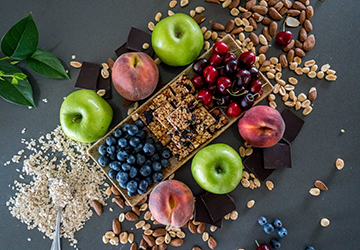How to Incorporate Mindful Eating Into Your Daily Routine
In our fast-paced modern world, we often eat in a hurry, neglecting to enjoy our taste and not realizing the nutrients our food provides. Our busy schedules and distractions create a gap between us and food, leading to overeating, digestive issues and a lack of awareness about what we eat.

The focus is on the idea of conscious consumption. Mindful consumption is a simple but effective way to reconnect with food, increase dietary satisfaction, and choose healthier alternatives. This article explores the principles of conscious consumption and how to incorporate them into your daily life.
Learn About Mindful Eating
Mindful eating is a mindfulness technique involving eating wholeheartedly without judging it critically or ignoring outside distractions. It increases awareness of our thoughts, emotions, and body sensations while eating. This practice has its roots in Buddhist mindfulness and has become increasingly popular recently due to its many health benefits.
The main goal of mindful eating is to promote a healthier, more balanced connection with food. It is not a diet or strict rules, but an approach to eating that can help you make better choices and get the most out of your meals.
Here, you'll learn some of the basic principles of mindful eating:
Eat mindfully: Instead of eating mindlessly, focus on the meal before you. Put away your phone, turn off the TV, and create a quiet dining environment conducive to concentration.
Enjoy every bite: Take your time to taste and enjoy your meal. Pay close attention to complex flavours, varied textures and delightful flavours. To enhance your cooking pleasure, take your time and consciously savour every bite.
Pay attention to your body: Your body's hunger and satiation signals. Instead of focusing on clearing your plate, eat when you're hungry and take breaks when you feel full.
Watch your thoughts: Pay attention to any thoughts and feelings that come up while you are eating. Do you eat out of boredom, stress, or genuine hunger? Recognizing these tendencies will help you make conscious eating choices.
Delight your senses: Engage all your senses while eating. Notice the bright colours and exciting food shapes, enjoy the sounds of prepared food and taste the delicious textures that unfold in your mouth.
Now, consider how to incorporate mindful eating into your daily life.
Start With a Thanksgiving Ceremony
Starting a meal with a gratitude ritual is a great way to create mindful eating habits. Take a moment to think about your food journey to get to your table. Please think of the farmers who grow the ingredients, the hands that prepare the food, and the resources that make it all possible.
This simple exercise can help you fully appreciate your food and lay the foundation for mindful eating.
Create a Relaxing Atmosphere
To fully practice mindful eating, you need to create a quiet environment. Turn off the TV, put away your electronic devices, and find a quiet place to sit and enjoy your meal. Eliminating distractions allows you to focus on the meal in front of you.

Chew Food Thoroughly
Consuming means savouring every bite; one way to do this is to chew your food thoroughly. This method not only improves taste but also optimizes the digestive process. Consciously eating at a moderate pace allows your body to absorb nutrients efficiently, improving absorption and health.
Attend and Participate
When you eat, make sure you give every bite your full attention. Observe the taste, texture and aroma of the dish. Immerse yourself in the experience and gently bring your attention back to the food when your mind wanders. Avoid participating in multiple eating activities to avoid excessive consumption and affect your dining enjoyment.
Assess Your Appetite
Before starting a meal, pause to assess your body's hunger signals. Do you eat out of genuine hunger, or are you driven by stress, boredom, or outside influences? Mindful eating encourages you to take in food when your body truly needs it, not just through daily or emotional triggers.
Part Control
Mindful consumption also involves paying attention to the amount of food on your plate. Make sure to provide adequate portions of food. If you want more, you can grab another serving. This approach can significantly prevent overeating while improving your ability to recognize and respond to your body's hunger and fullness signals.
Take a Break Between Bites
A helpful mindful eating technique is to put down your utensils between bites. This simple action forces you to slow down and enjoy your food instead of mindlessly shovelling it. It also allows your system to recognize when you are full, making you less likely to overeat.
Listen to Your Body
Pay attention to your body's satiety signals when eating. Ignoring these signs is easy when you eat quickly or are distracted. By listening to your body, you can stop eating when you feel satisfied instead of continuing until your plate is empty.
Mindful Snacking
Mindful eating isn’t limited to main meals. Apply these principles to your snacks, too. When you snack, choose something nutritious and take the time to enjoy it. Avoid mindless snacking while working or watching TV.

Practice Mindful Cooking
The process of cooking itself is a mindful experience. Rather than rushing to prepare food, take your time to enjoy the ingredients, colours, and flavours. Thoughtful cooking efforts can strengthen your relationship with the food you prepare, increasing awareness and satisfaction when eating.
Conclusion
Incorporating the practice of mindful eating into your daily life can have a significant and positive impact on your overall health and quality of life. You can develop healthier eating habits and enrich your dining experience by consciously reconnecting with food. Make every bite count, and pay close attention to your body's hunger and satiety signals.
It will help you make more informed decisions about your diet without overindulging. This method allows you to enjoy your meal fully. Mindful consumption is not a short-term diet plan but a lasting habit that can transform your relationship with food. So, at dinner time, eliminate all distractions and enjoy every bite. Your body and mind will appreciate this mindfulness strategy.







